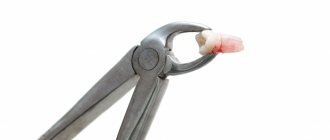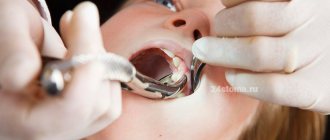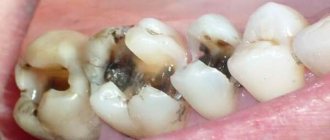Not a single person is immune from a situation with a chipped tooth: even strict adherence to the norms and rules of hygiene, a healthy lifestyle does not exclude such risks, because one of the causes of chips is injuries.
The good news is that in most cases, you can restore your tooth to its original shape and function, and your smile to its beauty quickly, painlessly and inexpensively. Modern dentistry has many recovery tools; the main thing is to try to see a doctor as soon as possible and not ignore the problem.
The difference between chips and other diseases
Many patients confuse chips with similar injuries or diseases of the oral cavity. However, despite the similarities, it is important to distinguish certain conditions into separate problems that require a completely different approach to treatment. The most common similar conditions are the following:
- Tooth fracture. It exposes the coronal and sometimes the root part of the pulp, which leads to its death; it is almost impossible to save a tooth with a root fracture - it must be removed.
- Wedge-shaped defect - looks like a chip in the cervical part of the tooth; it is a non-carious lesion. In especially severe cases, such an enamel defect can cause the entire crown to chip off.
- Chip accompanied by dislocation. It usually appears as a result of injuries and complicates the treatment process, since the doctor’s task is not only to restore the shape of the crown, but also to treat the dislocation.
That is why, in cases where part of a tooth has broken off, an accurate diagnosis is carried out. Mechanical injury requires careful assessment of the consequences before starting treatment. The dentist may prescribe x-rays and other examination methods and methods to exclude serious consequences of damage.
Ask a Question
Consequences of injuries
Despite following measures at home, a late visit to the doctor can result in some complications:
- infection of the pulp, development of inflammation, severe pain;
- increased tooth sensitivity;
- root fracture, inflammation of periodontal tissues;
- tooth mobility, high risk of loosening and loss;
- violation of the correct closure of the jaws;
- formation of cysts, granulomas as a result of the inflammatory process.
In order to eliminate dangerous consequences, it is important to take an x-ray. If serious violations are detected, the doctor will prescribe treatment and take measures to prevent consequences.
Reasons for chipping
The mechanism for the development of chipping is a mechanical effect on the tooth enamel. But one person can crack nuts with his teeth, while another may have enamel chipped off as a result of eating seeds. This means that weakened enamel is a major risk factor for chipping. There are several reasons for its weakening:
- Frequent, repeated injuries, for example, in connection with professional or sports activities, traumatic hobbies.
- The habit of chewing pens or pencils, opening bottles with teeth, etc.
- Demineralization of enamel - areas with a reduced amount of minerals, which may be associated with endocrine diseases, poor nutrition, age-related changes and more.
- Caries, which is not noticeable during a normal visual examination - cervical or interdental, is not detected immediately, but can quietly destroy the tooth and make it more fragile.
- Malocclusions, in particular crossbite: due to the defect, the chewing load is distributed incorrectly. As a result, pressure increases on one group of teeth, which weakens the enamel.
- A chipped tooth may be associated with a filling defect, secondary caries, etc. In addition, removal of the pulp during endodontic treatment can lead to a weakening of the tooth enamel structure.
- Fixation of an orthodontic structure on weakened tooth tissues.
- Violations of hygiene rules are an indirect cause, but the accumulation of dental plaque and the formation of hard dental deposits can become a factor in greater vulnerability of the enamel.
- Consumption of hard, viscous foods.
- Temperature difference - eating hot and cold food and drinks at the same time or alternately. This causes small, invisible cracks in the enamel and weakens its structure.
- Bruxism, diseases of the temporomandibular joint, dystonia of the masticatory muscles, leading to jaw closure, voluntary and involuntary grinding.
- Smoking. Changes in the acidity of the oral cavity, saliva composition associated with systemic diseases, dietary habits and other factors
We found that a tooth is more likely to chip if the enamel is weakened or its structure is changed. However, chips are different, each case requires a special approach and the selection of individual restoration measures.
Advantages and disadvantages of each extension method
Extension using pins
The advantages of this method:
- Simple simulation of an artificial organ.
- The pin is a single piece, giving the tooth strength.
- During the procedure, neighboring organs are practically not affected.
Minuses:
- The nerve in the tooth dies and it may darken.
- Secondary caries may occur.
- The walls of the tooth gradually become thinner during use, which can cause chips.
Using crowns
Advantages:
- there is no risk of secondary caries due to the tightness of the structure;
- the remaining tissues are not damaged;
- achieving high strength;
- maximum aesthetic smile.
The downside is the risk of the crown moving away after some time.
Types of chips
There is a conditional classification of chips:
- Enamel chip - in this case, the patient will most likely report that a piece of the tooth has broken off. This injury is not accompanied by pain. Sometimes the defect is not even noticeable and invisible to the eye. In certain cases, trauma can lead to increased sensitivity of the causative tooth to cold, hot, sour and sweet foods, and cool air.
- Dentin chip: in this case, the patient observes that a rather large piece of the tooth has broken off. The injury is visible to the naked eye, and unpleasant or painful sensations appear. If the dentin chip is not repaired quickly, the tooth will quickly continue to deteriorate.
- A deep chip that leads to exposure of the pulp as a result of a fracture of the tooth crown. Opening the pulp chamber can lead to bleeding, always accompanied by acute pain. However, taking analgesics rarely brings the desired result. In this case, it may not be possible to save the pulp even if you consult a doctor early, but it is important to visit the dentist as soon as possible in order to save the tooth and get rid of pain.
Dietary recommendations
If your teeth are susceptible to chipping and cracking, then you should include in your daily menu foods that are sources of calcium, vitamin C, phosphorus and fluoride. To strengthen enamel it is useful to use:
- Hard cheese and various cheese products.
- Natural, not sterilized milk.
- Dairy products.
- Nuts, sesame seeds, sunflower and pumpkin seeds.
- Greens (dill, parsley, etc.).
Proper nutrition: high-quality dairy and fermented milk products, cheeses, herbs and nuts - all these products help preserve the structure of the teeth and strengthen the enamel, so it is necessary to include them in your diet.
The listed products must be included in your diet, both for adults and for children, since without the necessary minerals it is impossible to ensure the correct formation of tooth enamel.
Symptoms of chipping
If the chip is small, no symptoms may appear. Sometimes a person begins to guess about a chip because of the appearance of roughness of the tooth or its sharp edge. If we are talking about a tooth in which the pulp was previously removed, then even a large chip will not lead to pain.
In the event that part of the enamel next to the installed filling was chipped, this can affect its service life and even cause immediate loss or destruction.
Despite the fact that a small chip sometimes only causes aesthetic inconvenience, it is better to restore the previous shape of the tooth crown as soon as possible. Otherwise, the tooth may continue to deteriorate, and the rough enamel surface is an ideal environment for the proliferation of cariogenic bacteria and plaque accumulation.
What to do if a tooth chips off
If a tooth chips, there is no need to panic. It is important to take no action until you can see a doctor. The most common mistakes are the following:
- attempts to “grind” the damaged area of enamel: this can lead to serious problems;
- an attempt to check the mobility of the tooth: it is not worth acting on it mechanically in any case;
- rinsing the mouth with antiseptics not intended for this purpose: as a result, burns of the mucous membranes and other complications.
How to help yourself in the first hours
You can rinse your mouth using regular or antiseptic rinses or chamomile decoction at room temperature. It is better to brush your teeth more carefully using a brush with soft bristles, and if you don’t have one, avoiding an injured tooth.
If there is a fracture of the crown and bleeding, it can only be stopped with a piece of sterile bandage or sterile cotton wool; there is no need to introduce material into the tooth! If acute pain is observed, you can take an analgesic; it is better to choose one that you have already taken before and the reaction to which is known.
It is important to understand that such measures do not eliminate the need to see a dentist as soon as possible. This will help preserve the tooth and prevent complications, quickly restore its normal shape.
Methods for restoring a tooth after a chip
In cases where a piece of a tooth has broken off, the doctor will conduct a visual examination. X-rays and other additional examinations may be required to select a treatment method.
For minor chips, it may be enough to saturate the enamel with minerals and make the surface of the damaged area smooth. This is especially true in cases where slight grinding of tissues will not lead to an aesthetic defect, for example, asymmetry.
With an average chip, it is difficult to do without the use of artificial materials. You will need to use a filling material, an artistic restoration method, or other tools to restore the shape of the tooth.
When the pulp is opened, it will most likely be removed, the root canals will be filled, and the crown will be restored with a filling or prosthesis. Sometimes it is not possible to restore a tooth. Then its removal and subsequent installation of an implant is required.
The method of restoration is determined by several factors: the degree of destruction, the diagnostic result and identification of the causes of the chip, the general condition of the oral cavity, the wishes of the patient, etc. Let us consider the methods of restoring teeth after various chips in more detail.
Hidden caries (both under a filling and on a “healthy” tooth)
As a rule, such caries develops asymptomatically, for more than one month or even a year, it does not manifest itself in any way, but destroys the tooth tissue from the inside. And at some inopportune moment, a part of the tooth, thinned by caries, breaks off.
What to do?
Treat the tooth at the dentist: remove all tissues affected by caries and restore the tooth (with a filling, ceramic inlay or crown, depending on the degree of its destruction). And be sure to check all other teeth for hidden caries!
How to avoid?
See your dentist for preventive examinations more often in order to promptly detect hidden caries at an early stage, when treatment is easier, faster and cheaper.
Artistic restoration
This method is also called extension. This method is widely used for noticeable chips and moderate chips. Restoration consists of layer-by-layer application of a special composite material. Each layer is illuminated with a special lamp. The doctor may use various tools to give the tooth a natural shape. This is a direct artistic restoration. It involves restoration directly in the patient’s mouth.
Indirect restoration involves the installation of restorative structures, previously made according to an individual impression in a dental laboratory. This group of methods includes ceramic veneers, inlays - fillings, pre-made in the laboratory according to exact parameters.
Both restoration methods can restore the shape and function of a chipped tooth effectively and aesthetically. Materials are selected to match the tone of your own enamel. Indirect restorations are more reliable and aesthetically pleasing.
Sealing
This method is indicated for chips that appear as a result of carious tooth decay, as well as for major damage to the tooth crown. In this case, radiographic examinations are often required. If the crown is significantly damaged, filling may be ineffective - the filling simply cannot last long. In this case, the doctor will offer alternative options.
If the pulp is damaged, filling alone may not be enough. First, the pulp is removed, treated and the root canals are filled. Then the crown of the tooth is restored using filling material or another method.
Installation of an artificial crown
A fracture of the crown of a tooth or a chip exposing the pulp may make it impossible to restore the crown portion using conventional composite materials. In this case, endodontic treatment is carried out - pulp removal, root canal filling, as well as installation of a pin and an artificial crown. It can be made of different materials: metal, metal ceramics, ceramics, zirconium dioxide. The choice of material is determined by the desires for strength and aesthetics.
In extreme cases, it is not advisable to restore a tooth even with a crown. So, if a piece of a wisdom tooth breaks off, restoring it in most cases is impractical. It does not bear a chewing load, so the dentist will suggest removing the figure eight. The same applies to cases of root fracture.
When is implantation needed?
Implantation is required if the root part of the tooth is damaged and cannot be used as a support for a prosthesis. This can happen when the side wall of the tooth is broken (below the gum level), deeply damaged by caries, root fracture, etc. In these cases, the tooth is completely removed and replaced with a titanium rod - an implant. Crowns are also placed on implants. These are metal ceramics and zirconium dioxide; ceramic prostheses are not used due to their high fragility.
Complications of chips
It is necessary to restore the shape of a tooth in case of chips of any scale to avoid complications. Most patients strive to get to the dentist as quickly as possible due to the unaesthetic nature of the problem, especially if part of the front tooth has chipped off. But there are other consequences that affect oral health. These include:
- tooth mobility, tooth loss;
- malocclusion;
- hyperesthesia of a damaged tooth - increased sensitivity;
- increased risk of developing caries and its complications in the form of pulpitis, periodontitis;
- injury to the soft tissues of the gums, cheeks, and tongue due to the sharp edges of the chip.
Therefore, it is important to visit a doctor and choose the appropriate restoration method.
Prevention measures
It is difficult to prevent chipped teeth, but you can strengthen the enamel and increase its resistance to mechanical stress. To do this, you should adhere to the following recommendations:
- adhere to the rules of oral hygiene;
- eat well;
- treat caries promptly;
- Visit your dentist twice a year for professional cleanings and examinations;
- give up bad habits, cracking nuts;
- undergo orthodontic treatment if necessary;
- keep systemic and endocrine diseases under control;
- minimize the risk of injury.
For an in-person consultation and choosing a method of tooth restoration, you can contact one of the STOMA clinics. The professionalism of our dentists and a wide range of modern high-quality materials allows us to offer patients high-quality treatment and effective restoration. You can make an appointment either by phone or through a special form on the website.
Home remedies for strengthening enamel
Unfortunately, it is not possible to achieve a significant restorative effect at home. However, remineralizing toothpastes, rinses and special gels can improve the appearance of enamel and help prevent infection. The special components of these products help saturate the enamel with vitamins and minerals, reducing sensitivity and restoring its protective properties. Strengthening toothpastes include: Splat Biocalcium, President Unique, Innova Sensitive, Biorepair and others.
Splat company, specializing in the development of highly effective products for professional care of teeth and gums. Biocalcium paste is an assistant in the fight for the regeneration of tooth enamel and reduction of sensitivity.











